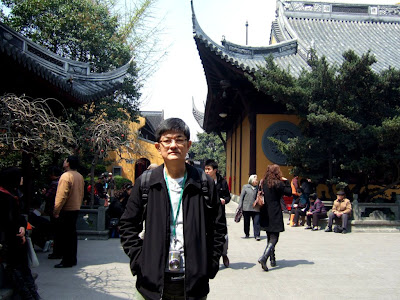
Within the concrete jungles in Shanghai, there are plenty of parks for people to recharge their batteries. Shanghai parks are splendid places for a stroll, combining scenic vistas and with people-watching. It is particularly lively at dawn or in the morning when locals gather for morning exercises, like practicing Taichi and dancing. Elderly males gathered in the park in the morning with their beautiful trained singing birds hanging around the area or at the branches of the trees. Freely, birds compete their voices and men sharing the joy of their life. Such an admirable scene !


Peach fully blossom in this little park garnished the nearby high-rise buildings and layers of overhead high ways.


Merrily enjoy color of pink offered by rows of peach plants under the concrete buildings .




Couples of aging locals bathing under the morning warm sun in the peach blossom park


Enjoying the stone sculptures in the park with the two little kids.


Although Shanghai is perpetually overrun with constructions, there are still some hidden spaces that have escaped the city's obsession with buildings.


Small rockeries, bridges, and man-made stream or lakes in a garden created a serene spot for people of city to at least breath comfortably for short minutes in a day.


Shanghai's Parks offer some reprieve from the urban jungle.




Incredibly, there are many gardens like this right at the center of Shanghai city.


The patch of greenery and some well-worn exercise equipment provide physical practice conveniences and links of relationships for the aging locals in the neighboring hood.




Peach just started to blossom in this little beautiful park near the city bus station.


Children enjoyed the green, the colors of the park, and the natural musical hymn and calls from the birds. in the morning.




How nice if all cities in the world would follow Shanghai's city planning to include a small corner of green inside the concrete world, for human to run away from stress and working pressure.


The pretty little bright red peach flowers are ready to greet the spring season.



While the pink flowers completely blossom without any hesitation.



Spring has come to Shanghai!



Under skyscraper, the tall and elegant white Magnolia flowers were also sharing joy of spring moment.





Touristic spots are always packed with people.

There are three main Buddhist Temples in Shanghai, namely The Jade Buddha Temple, Longhua Temple and Jinganshi. We only concentrated on the last two as we have visited the most famous Jade Buddha Temple in our last trip and had paid respect to its 5 ft tall pale-green Burmese Jade Buddha housed at the back of the complex.



The activity of evening bell-striking ceremony on 31st December at 2400 hour to welcome the next new year had become one of the eight attractions of Shanghai. The 6.6 ft high x 51 inches in diameter big drum weighs 5 ton. It is housed in the Bell and Drum Hall.



Longhua Temple is the oldest and largest Buddhist Temple Complex in Shanghai. It was founded in 3rd century at 242 AD. The 40 meters 7-storey high Pagoda dated only from 10th century was not opened for visitors. It indicated the beautiful architecture of Song Dynasty.





Longhua Temple occupied a land of 20,000 sq. meter (about 5 acres) with five major halls. Besides the Grand Shrine for Great Sage Buddha Skyamuni and his two disciples, the 5 halls also includes Three Sages Hall of Pure Land, Sutra Keeping Hall, Abbot Hall and Maitreya Hall with 4 heavenly kings.



The Temple was destroyed during Tang Dynasty (618-907) but rebuilt in Northern Song period. But in actual, most of the temple buildings in the complex were reconstructed during the reign of Emperor Tongzhi and Guangxu in Qing Dynasty.



Longhua Temples like the other two temples in Shanghai and most of the temples in China, is practicing Mahayana Buddhism.




The auspicious gold gilded Buddha Image enshrined in the Main Shrine Hall.



Different images of Goddess of Mercy Guanyin Bodhisattva.



The Thousand Luohan Hall where thousand golden status of arahats, the enlightened Buddhist Saints were displayed for worship and respect.



Since Ming Dynasty, there was a folk gathering day at the 3rd day of 3rd lunar month every year in the temple to admire the peach blossoms. There were stalls and folks arts and games in the carnival. The practice had now become an annual temple fair where hundreds of stalls selling traditional Chinese food and trinkets inside the temple compound.



Chinese Temple including Buddhist Temples are still practicing burning great incenses and gold or silver foiled papers.


Enjoy a bowl of vegetarian noodles or rice at a cost of RMY5.00 under warm sun and rest before the ceremony starts.



The stone plaque offered in this little pavilion at the liberation pond was from Song dynasty.



Longhua Temple was originally surrounded by extensive gardens and orchards and it was a big lure for people in surrounding cities when huge area of peach blossom start blooming. Today though no many of the peach plants left, it is still an attraction when blossom.






The memorial garden of the war heroes is just next to the temple. Huge crowd of local elders visiting the garden to show their respect during this "qingming" festival.


Jingan Temple was located at 1686 Nanjing West Road, one of the busiest district in Shanghai.



It is very popular for tourists. Firstly the temple looks very impressive from outside with imposing wall and secondly, there is an airport servicing bus station nearby.



The temple was first founded in three kingdoms period but moved to the present site in Song dynasty.



It was destroyed in 1851 and rebuilt and was turned into a plastic factory during cultural revolution.



The present Jinganshi when renovated in 1983 maintained the beautiful architecture of Song Dynasty.



No comments:
Post a Comment